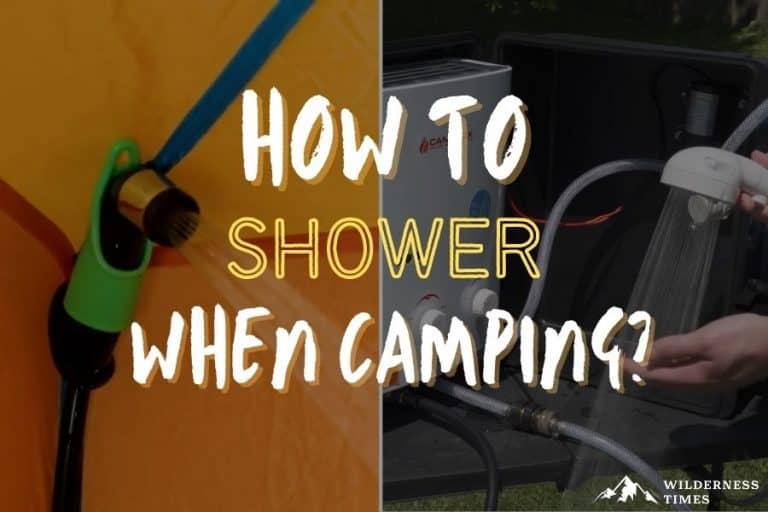Hygiene is one of the main concerns of many new campers.
How does one stay fresh while out in the wild? Can you actually shower when camping?
The good news is – yes, you can.
In fact, there are many ways you can keep up with your hygiene on your camping trip. And in this article, we’ll cover everything you need to know about showering when camping.
Let’s dive straight in.
How to Shower When Camping
So, how does one get a bath while out in the wilderness? Well, you actually have a couple of options available.
Book a Campsite with Showers
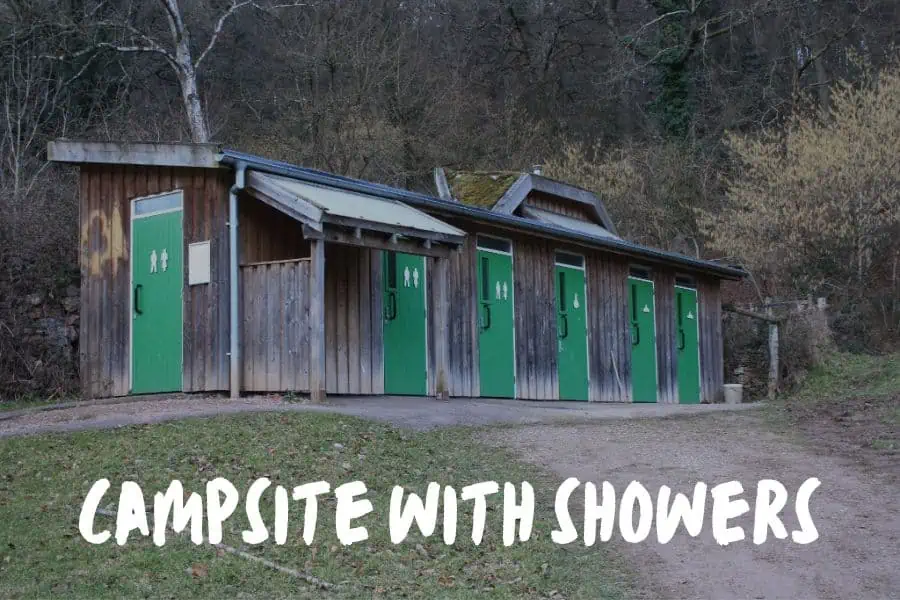
As you probably know, there are a lot of campgrounds that offer showers as part of their restroom facilities.
Depending on the campground they could be available on a pay-per-use basis.
But most likely they’re probably included in the overall price of your stay.
Having a proper shower when camping sounds super convenient, right? However, you should be aware of a few things.
First – they can get quite busy, especially during camping season.
If you try showering between 8 and 10 AM or around dinner time, don’t be surprised if there’s a waiting line.
And for the same reason, your showering time is also limited.
You might spend half an hour just enjoying hot water when showering at home, but that won’t work here.
You should be considerate to other campers waiting for the shower, so don’t spend more time than necessary showering.
Personally, I prefer hitting the showers early in the morning – like, before 7 AM early – to avoid the crowd and have a bit more privacy.
But of course, I still try to make it at quickly as possible so that I don’t occupy it for too long.
Don’t forget to pack all your necessities before you get to the showering facility.
While there’s water (which can be hot, but that’s not the case with every campground), you need to provide your own toiletries.
One thing I definitely recommend using is shower shoes.
No matter how clean the showering facility might seem, the floors can be covered in bacteria and other pathogens.
Ringworms and athlete’s foot are just two examples of diseases you can easily catch this way.
Invest in a Camping Shower
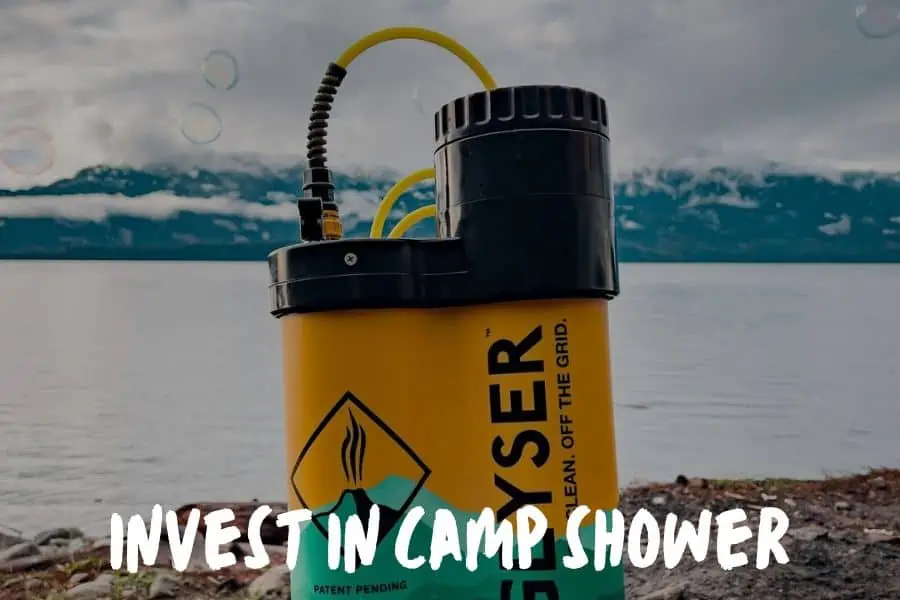
If your campground has no showering facility or you’re simply camping outside of a campground (dispersed camping), then why not bring your own shower?
These days, portable showers come in all shapes and sizes.
Some have a rather minimalistic design, while others are almost as good as the shower you have at home.
Generally, we can divide them into three categories: gravity, pump, and tank camping showers. We’ll go over each one later in the article.
Get a Shower Tent (Privacy Tent)
Now, regardless of the type of camping shower, one thing that can make your showering experience more comfortable is a pop-up shower tent that you can use as a privacy cover.
With this method, you can use a shower tent, PLUS a portable camp shower system.
In most cases, the tent also features towel hooks, pockets for necessities, and even drainage floor pads (or no floor at all).
Shower tents are great, as they offer privacy and convenience.
However, they can be pretty bulky and take a lot of time to set up, making them unsuitable for backpacking or car camping when storage is tight.
Go All-Natural: Lakes and Waterfalls
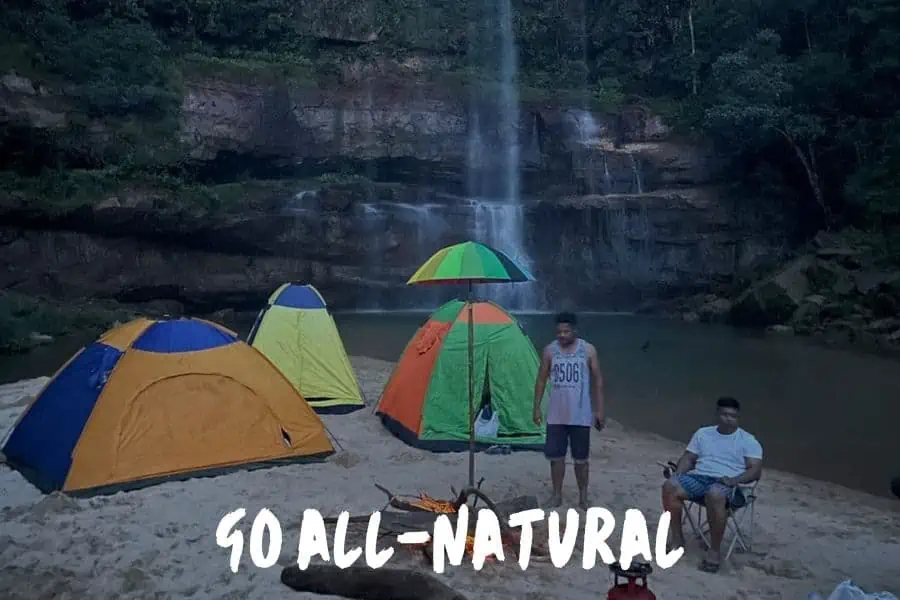
Camping near a body of water, be it a river, lake, pond, or even the ocean? Then why not make the best use of it and use it to refresh your body?
If you find a nearby waterfall, even better. The fast water motion really helps with cleaning all the dirt from your body.
Now, I definitely recommend wearing water shoes, as the bottom can be slimy and slippery, so shoes can prevent you from falling.
On the other hand, what you don’t want to do is use soap or shampoo.
It doesn’t matter whether the product is labeled biodegradable, non-toxic, all-natural, or eco-friendly, you shouldn’t use it to wash in a body of water.
No matter how good for nature a product might appear to be, it’s still not natural and can affect water biodiversity.
They all contain chemicals, which can be toxic to living creatures inside the lake or river.
Use Your RV Shower (Indoor / Outdoor)
If you’re camping in an RV, why not make the most out of your vehicle?
Most RVs feature a shower inside. And while it’s probably smaller than the one you have at home, it definitely works the same way.
You can enjoy hot water and privacy you don’t typically get when you’re showering on a campground.
Some better-equipped RVs might even have an outside shower, which is handy if you’re camping near a beach and you want to refresh and rinse salt from your skin.
Take a Quick Sponge Bath
No shower or body of water at your disposal? That’s no reason why you can’t take a bath. In this case – a quick sponge bath.
For this, you need a bit of water, some kind of container or a bottle, soap, and a sponge.
This method is pretty basic – you splash a bit of water on your body to get wet, scrub with a bit of soap, then rinse the sponge and use it to remove soap from your skin.
As you can see, this is a pretty conservative method.
You can get away with as little as 12 ounces of water if you use it properly. Not ideal, but it gets the work done.
Use Dry Shampoo in a Pinch
Of course, I don’t mean you should use dry shampoo to wash your body – it’s for your hair.
Washing your hair can be rather difficult when camping, especially if your hair goes past your shoulders.
Not only that you need a lot of water to get it all soaked up and then rinsed, but you may also need to dry it fast if the weather is cold.
That’s where dry shampoo comes to shine. This neat little product is used on dry hair, and it soaks up the excess oil and grease, giving you a refreshed look.
Oh, and it makes your hair smell great as well! But don’t go overboard with smell, as you don’t have to be the main attraction for all the insects, especially mosquitoes.
Use the Household Product Method
Interestingly enough, many of the household products you have at home can help you maintain hygiene when you’re out in the wilderness.
One of my favorite ones is baking soda. First, you can use it to get rid of greasy hair.
Just sprinkle a bit on your scalp and then massage it to soak up all the dirt and oils on your hair. It works just like dry shampoo!
You can also use baking soda to clean your teeth in case you’ve forgotten your toothpaste.
Just Add a few drops of water to make a paste, then use it to brush your teeth. It also helps with your breath as well.
Finally, you can pat some baking soda underneath your armpits, and it will work like a deodorant.
Vinegar can also be used as a deodorant. Just spray a bit or apply with a cotton pad, and it will mitigate the odor and even do a gentle skin peeling.
Baby Wipe Wipe-Down
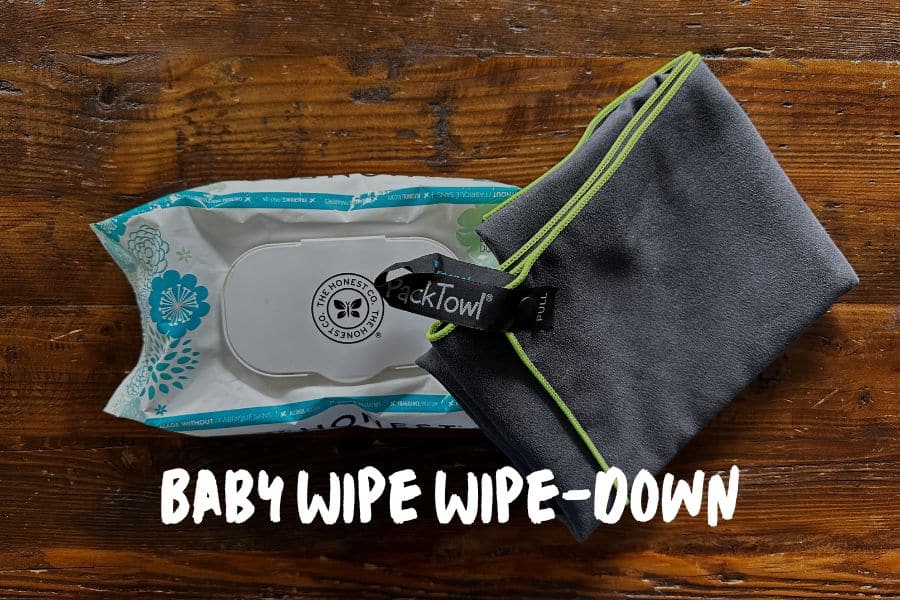
Let’s say you don’t have a single drop of water at your disposal for showering. In that case, you can use baby wipes to refresh and wipe away the dirt and sweat.
I say baby wipes because they’re very gentle and won’t irritate your skin, even when it comes to your face. But if your skin isn’t sensitive, any wet wipes will do.
In fact, certain outdoor brands make their own wipes, which are designed to be lightweight and easy to store.
This type of wet wipe is great because they’re larger than regular wipes, which is more convenient for cleaning your body.
Furthermore, they tend to be very gentle and moisturizing, yet very effective at removing dirt.
Some of them are even biodegradable. Still, you shouldn’t leave them out in the wilderness, but pack them up with you.
Even biodegradable wipes take time to decompose, meaning you’re still “leaving a trace” behind.
Do’s & Don’ts of Showers When Camping
Okay, let’s talk rules. There are a few do’s and don’ts you should be aware of when you’re showering at your campsite.
Use Eco-Friendly Soap and Shampoo
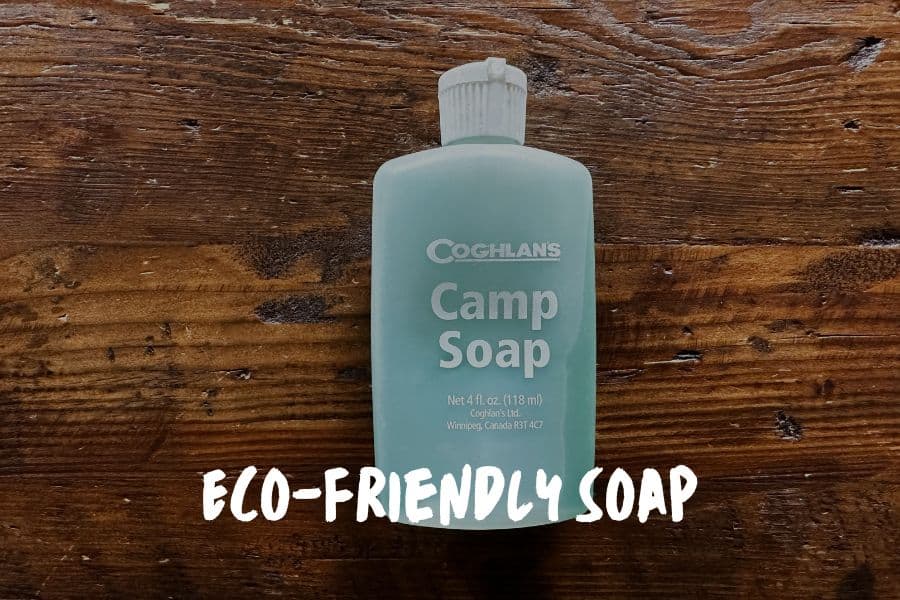
While shampoo and soap you use at home might be gentle and good for your skin, they’re not good for the environment.
They contain a bunch of chemicals that don’t break down and can harm both flora and fauna.
Biodegradable products, on the other hand, will break down within six months or so.
But before you use such a product, make sure it really is safe for the environment.
Nowadays, many products are labeled as eco-friendly or all-natural, but that’s merely a marketing trick.
Make sure your soap and shampoo are really biodegradable by checking the ingredient list. It shouldn’t have any silicones, phthalates, sulfates, or parabens.
Never Use Scented Products
A perfume might be part of your everyday routine, but you should refrain from using it when you’re out in the wilderness.
Why? Because it attracts insects! From mosquitoes to flies and even wasps, these bugs will be attracted to your lovely smell from a great distance.
Not to mention, these scents can attract bigger and more dangerous animals, like bears. And bears can pick up scents from very, very, far away.
Use Beach Towels or Microfiber Towels
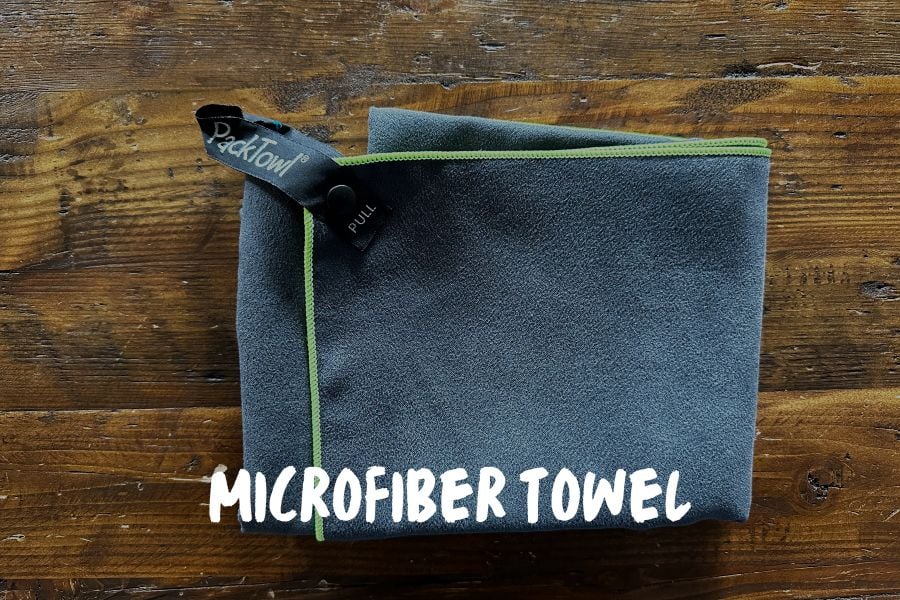
A beach towel is much bigger than your regular bath towel, so it’s more suitable for camping.
You can wrap your whole body with it and dry your body quickly, which is especially handy during colder days.
Microfiber towels are great for camping since they dry up pretty quickly.
They can be quite useful for backpacking and hiking, as you can pack them up relatively fast after use.
Regular towels, on the other hand, can take several hours up to a day to get dry.
Use the Least Amount of Water
This is a no-brainer if the only water you have available is the one packed in bottles and canisters inside your trunk.
You’ll need that water for washing dishes and maybe even drinking (unless you have store-bought water for that purpose).
But even if you’re using a shower at the campground, you still want to be conservative with water.
Water, especially hot water, can be limited, so be considerate of other campers waiting to shower as well.
Bring Hand Sanitizer
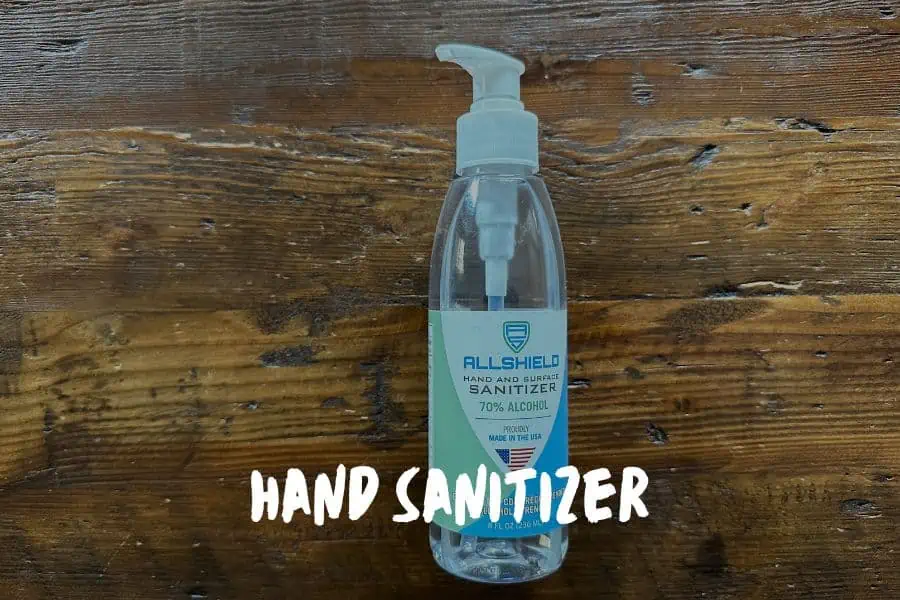
When you’re out in the wilderness, your hands get dirty all the time.
If you were to wash them with water every single time, you’d run through your supply rather fast.
This is where hand sanitizer comes in handy. A few drops are more than enough to get your hands squeaky clean, so a bottle can last you the whole trip.
Just remember that hand sanitizers may contain alcohol or other ingredients that can be harsh on your hands.
If you can’t get your hands on one that’s alcohol-free, pack up a hand cream and use it diligently throughout the day to keep your hands moisturized.
Wash Up in the Sun
Don’t wait for the night to fall to shower.
Temperature can drop significantly, making showering rather uncomfortable.
Instead, shower during the day, when the sun is still high up in the sky. Not only is it warmer then, but you’ll also dry down much faster.
Bring Your Sense of Adventure
Don’t be afraid to wake up your adventurous side. See a pond nearby? There’s no reason why you couldn’t jump in and swim a bit to chill down and refresh.
Even though swimming in the ocean leaves you with salty skin afterward, that’s not a bad option either if you’re camping close to the coast.
In fact, seawater is great for relaxation due to all the minerals in it, and it’s antibacterial as well!
Also Read: Camping Etiquette: Understanding the Rules of Camping for a Positive Outdoor Experience
Water Conservation Techniques During Camping Shower
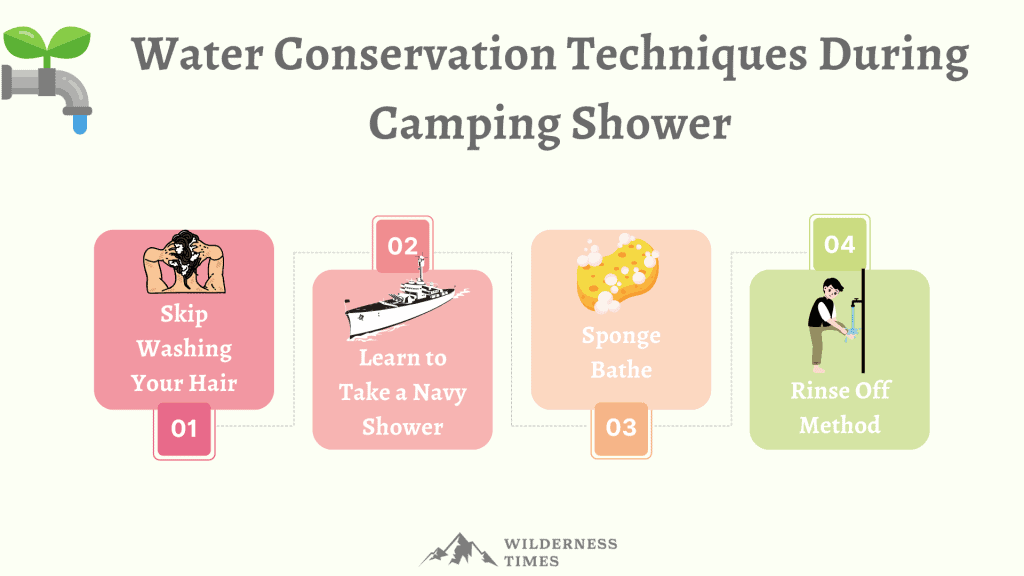
Showering when camping can be quite challenging at first, especially because you need to be quick and conservative with your resources.
Here are a few techniques that come in handy in this case:
Skip Washing Your Hair
Simply, washing your hair uses way too much water, especially if it’s long.
First, you need to soak it up properly before applying shampoo, and then you need a lot of water to make sure there’s no residue left in your hair.
Oh, and let’s not forget about applying and rinsing conditioner afterward, if you use it.
You could take five body showers with that amount of used water. Of course, you should always opt for dry shampoo instead, if possible.
Learn to Take a Navy Shower
The name of this method comes from showering on naval ships, where conserving fresh water is especially important.
So, how does it work?
- Turn on the shower to wet your body.
- Then, turn off the water while you’re soaping up and scrubbing your skin.
- Apply shampoo at the same time.
- Finally, turn on the water to rinse the products.
Pretty simple but effective – the water is only running when you absolutely need it.
Sponge Bathe
This method uses the least amount of water, so it’s suitable for dispersed camping.
Basically, you’re showering like they used to do back in the day on courts – by using a sponge. Of course, this method doesn’t include a fancy tub filled with water.
But the cleaning practice is pretty much the same.
Fill a container with water and soak the sponge, then use it to wet your body. Then, apply soap on your skin, and use the soaked sponge to remove it in the same manner.
Rinse Off Method
This method should be combined with any of the previously mentioned ones for optimal water usage.
For this, you need to be standing while showering.
- First, you splash a bit of water to wet your body (and hair if you’re washing it).
- Turn off the water while soaping, then start rinsing your body from the top.
- The idea is that the water will drip from the top onto your body, thus rinsing it as well.
Types of Camp Shower Systems
If you decide to invest in a camping shower system, then you’ll need to consider what type works best for you.
Generally, camp shower systems can be divided into three categories: gravity shower, pump shower, or pressurized tank.
Gravity/Hanging Bag Showers
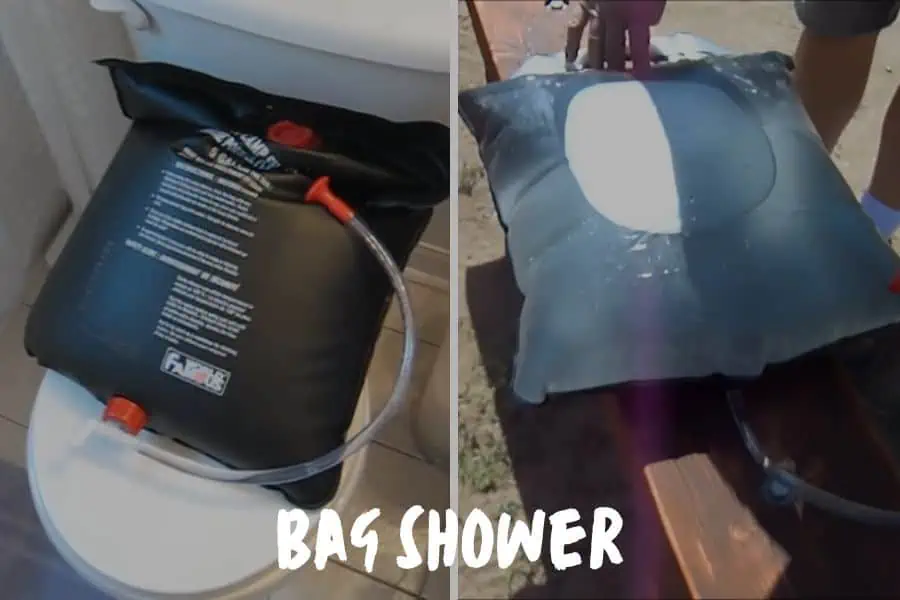
Hanging bag showers are the basic type. They’re filled with water and hung upside down, allowing gravity to take care of the flow rate.
The sun is responsible for warming up the water, so if it’s a nice day, you can expect your water to be relatively hot.
During a cloudy day, on the other hand, you’re not so lucky.
Of course, you can always fill the bag shower with water prewarmed on the stove, which is quite a hassle, to be honest.
As you can see, the design of bag showers is rather basic, but that’s why they’re rather affordable.
Getting one of these won’t break the bank, which is great. Plus, they can be packed pretty compactly when not in use, which is always a plus.
Pump Shower (Battery or Foot Powered)
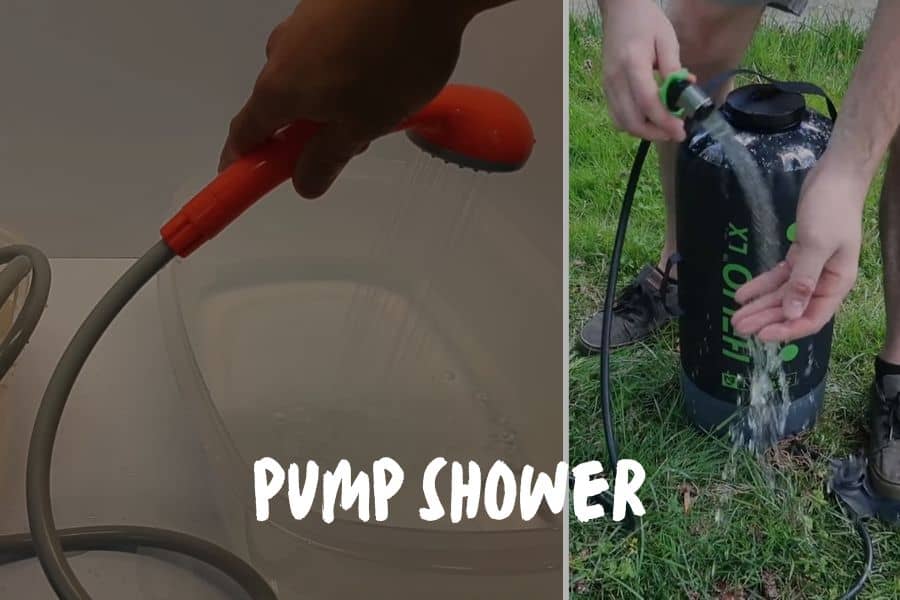
The second type of camp shower system you’ll see are pump shower systems.
The first type of pump shower is a foot pump shower, in which you use your own energy (foot pump) to generate pressure and push water through the faucet.
Foot pumps work great in that you can control the pressure and don’t need any additional equipment, batteries, or buckets to function properly.
The second type of pump shower is a battery-powered pump.
This type of shower requires a bucket of water that you can place the pump into and then the batteries will do the work for you to generate pressure.
A battery-powered pump may also be attached to a tank shower, but they also come separately as well.
Tank Showers
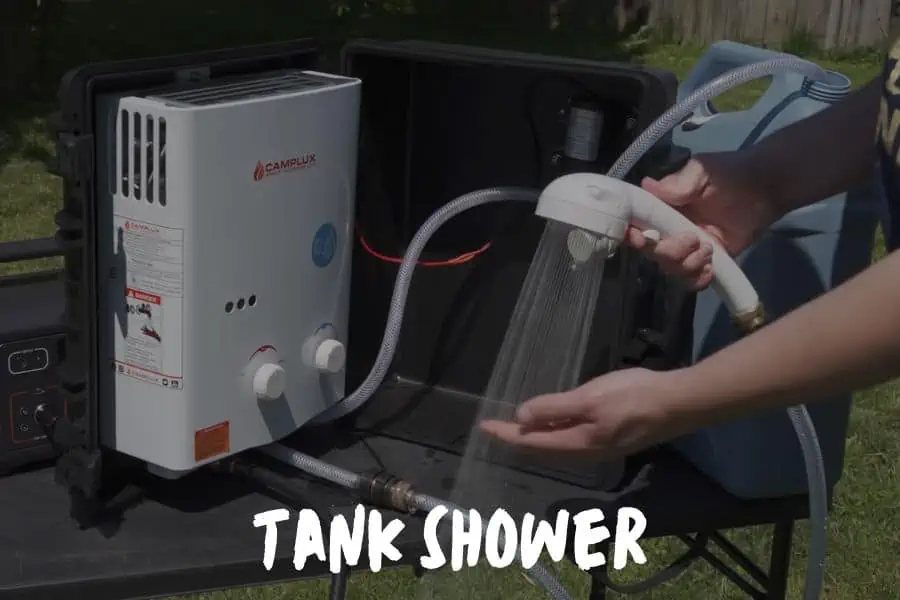
Tank showers can be divided into two categories – pressurized and electric showers.
Pressurized camping showers, as the name suggests, require you to pump air into them, which builds up pressure and allows water to go through the nozzle at the same rate as it would through the shower you have at home.
Great, huh? However, keep in mind that pressurized camping showers can be bulky.
Plus, you’ll need to bring a pump with you, whether it’s the classic bike pump or an air compressor.
Electric camping showers are the most sophisticated of them all.
They use a battery to pump water and even heat it up, so you can shower as you would at home.
Of course, you still need to conserve water as sources are scarce when you’re out in the wild.
Ways to Stay Fresh Without a Shower While Camping
If you wonder if there’s a way to stay fresh without taking a shower, the answer is yes.
Not ideal, but given the circumstances, these three methods will get the job done.
Wet Wipes
Of course, the easiest method is to simply use wet wipes. These, especially if they’re labeled as “baby” or “sensitive” can work for any part of the body, including your face.
Ideally, you want to find packaging that features a lid, as it allows you to completely close it so that the wipes don’t dry down.
Once dry, they won’t do anything in terms of hygiene.
Focused Washing
Even when I can’t take a shower, washing my face and neck helps me refresh in the morning.
It’s not the same as showering, but at least some parts of your body are cleansed.
During summer, what helps me most is washing my hands all the way up to my shoulders.
That way, I can quickly cool down as if I was splashed through the shower nozzle.
Camp in Cooler Weather
Unless you’re engaging in some physically intense activity, you probably won’t sweat during winter.
On the other hand, you can feel as if you just ran a marathon just by sticking your head out on a hot summer day.
So naturally, you can go longer without showering during colder months of the year.
In fact, you may not even think about getting wet during such temperatures!
Camping Hygiene and Travel Bathing Accessories
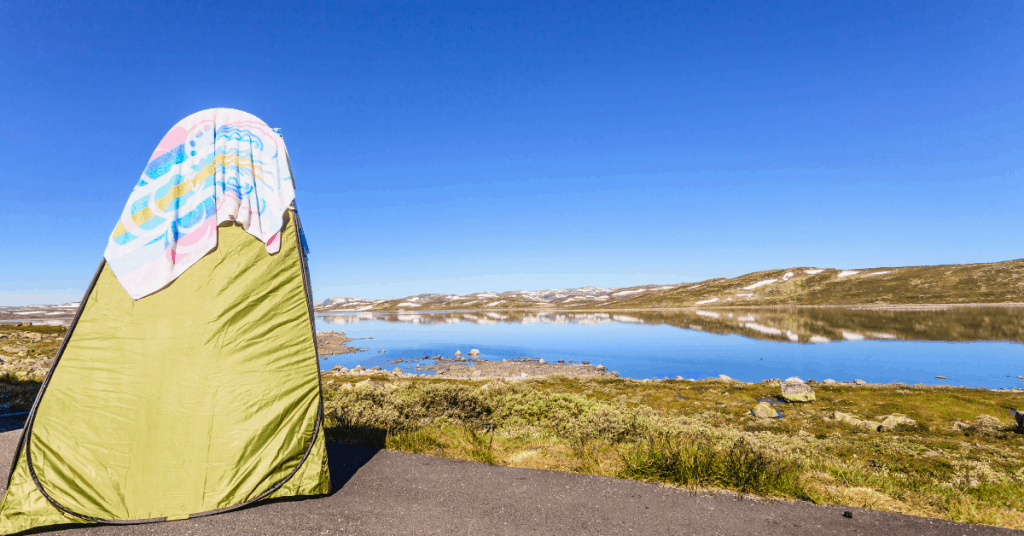
Finally, let’s talk accessories. Here are some things you’ll need in order to take a shower when camping.
Shower Tent
Depending on your surroundings, you might have a hard time finding a space that’s secluded enough to turn into a shower room.
But why go to such lengths when you can actually buy a shower tent?
These come in all shapes and sizes, and they’re made of waterproof material.
Depending on the model, a shower tent can also feature a drainage floor, which makes maintenance so much easier.
What’s also great is they are easy to set up and pack down pretty compactly.
Quick Dry Towels
While you certainly can bring the towel you use at home, it’s much better to stick with microfiber towels when camping.
These towels dry down pretty fast, so you won’t ever need to pack up a wet towel.
What’s more, they are quite durable and easy to clean, so they’re a great option for camping.
Toiletry & Shower Bag
Surely, you’ll need a toiletry bag to pack all your hygiene products.
This comes especially handy when you’re camping at a campground, as you can bring all the necessities with you to the showering facility.
And when you’re done showering, you also have your toothbrush and hairbrush packed, so you can do all of them in the same place.
As for the shower bag, it basically allows you to get into the shower with all of your stuff right next to you without getting them wet.
That way, you can dress up while still in the shower for more privacy.
Portable Camp Shower System
Finally, if your campground doesn’t have a showering facility, then you can always bring your own.
Combine it with the shower tent and enjoy a home-like showering experience while out in the wilderness.
FAQs
How do you take a warm shower when camping?
That depends on the type of shower you’re using. For bag and pressurized showers, you either leave it in the sun to warm up or add preboiled water to it.
As for the electric ones, they feature a battery that can warm up the water.
Where do you shower when wild camping?
You can set up a shower wherever you want, as long as it’s 200 feet away from any body of water, to prevent soap and shampoo from getting into it, thus causing contamination.
How often do you shower while camping?
Given that water source is scarce, it’s best to shower as little as possible. In between showers, you can refresh with wet wipes or focused washing.
What are the don’ts in camping showers?
The main don’ts are using any products that aren’t biodegradable and safe for the environment.
You should always respect “leave no trace” principles, even when it comes to your hygiene.
To Sum Things Up
Showering when camping can pose certain challenges, especially if the campground doesn’t offer a showering facility.
There are many things to pay attention to, from how you shower to the products you’re using when showering.
But as long as you stick to the rules and are conservative with your supplies, you should have no trouble refreshing while you’re camping.


